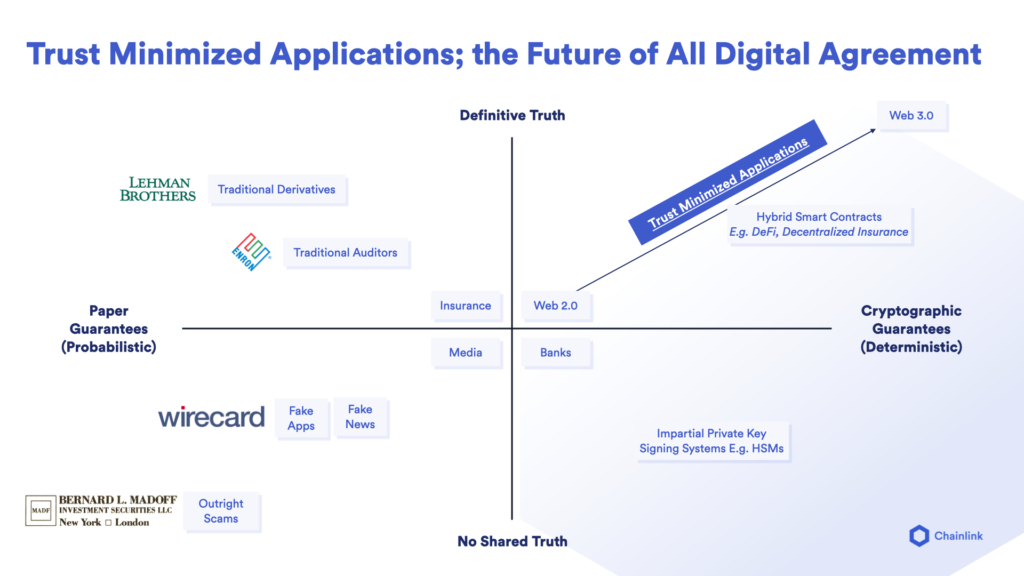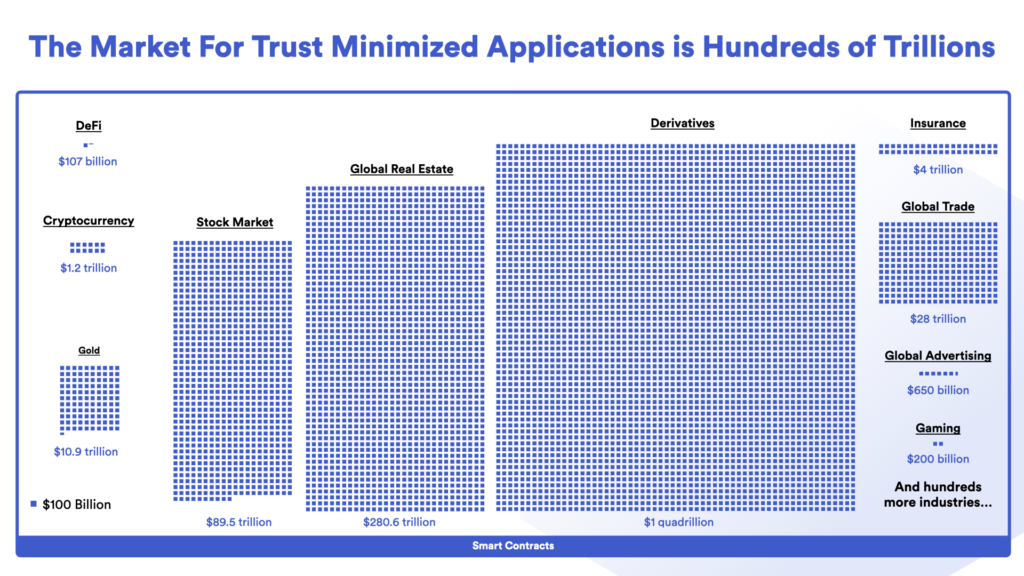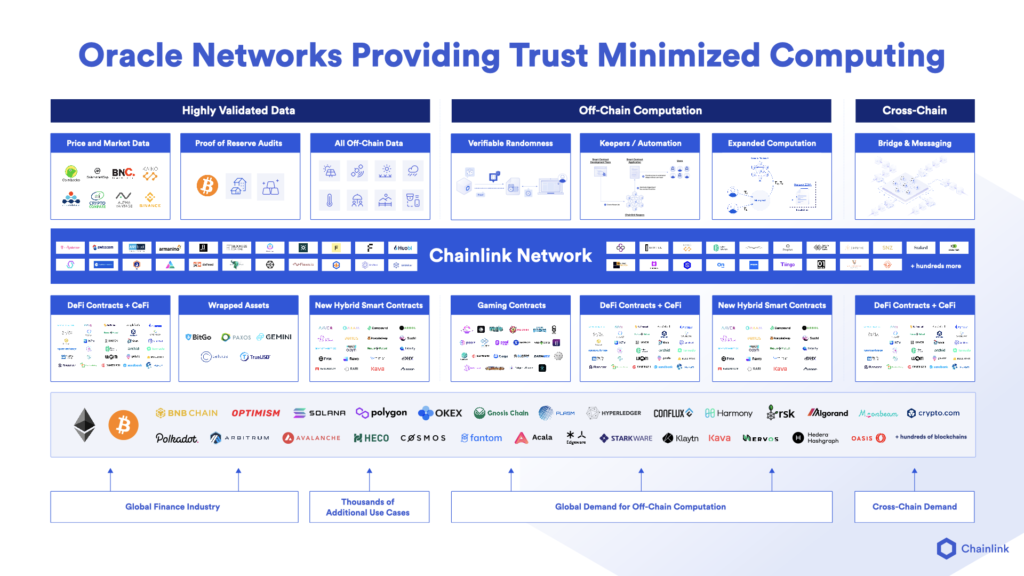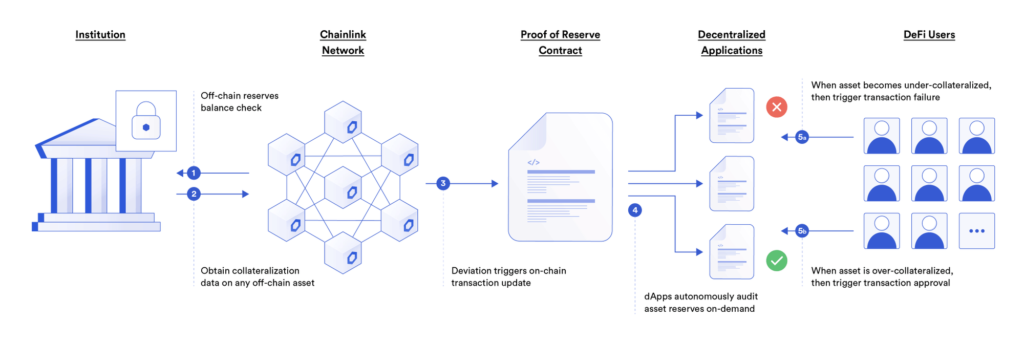The Market for Trust-Minimized Applications
While Web3 goes by many different names—the blockchain ecosystem, the crypto economy—the underlying value that this new computing paradigm ultimately provides to users is cryptographic guarantees. The rise of encrypted messaging and new economic landscapes like decentralized finance are proof that cryptographically-guaranteed relationships are quickly becoming the new minimum standard for the modern user.
This new standard heralds a societal shift toward trust-minimized applications as a superior alternative to “trusted” third-party service providers and centralized platforms that have time and again breached the trust of their users. This shift to trust-minimization is poised to transform every global industry.
In the post below, based on Chainlink Co-founder Sergey Nazarov’s presentation on Chainlink Economics 2.0 and the Market for Trust-Minimized Applications, we explore the societal forces that have led to this new user expectation and the role of oracle networks as key infrastructure for the multi-trillion dollar trust-minimization market.
The Rise of Cryptographic Guarantees as a Societal Defense Mechanism
More and more over the past decade, society has developed a defense mechanism for the misbehavior of institutions and, most recently, a defense mechanism for the misbehavior of technology platforms as institutions. That defense mechanism is encryption. We have already seen, even in the last decade, the application of cryptographic guarantees to bring society to a place where it can do key things like communicate.
Approximately 10 years ago, very few people knew or understood what end-to-end encryption was or why somebody shouldn’t send sensitive information over an SMS text message through a telecommunications system. 10 to 15 years ago, everybody would send the most sensitive information over unencrypted messages through text messaging on your standard SMS mobile application. Now the average teenager and the average consumer knows what end-to-end encrypted messaging is. At the top of certain widely used messaging applications like WhatsApp, at the top of every chat session, it says “end-to-end encrypted,” and then it even describes what that means in a sentence.
Why has the world shifted from sharing everything over unencrypted channels to the average user wanting to use end-to-end encrypted messaging systems like Signal and others?
It’s because the institutions—whether they were larger technology institutions, governmental institutions, or technology platform institutions in the form of Web2—failed. They failed their users, and those users lost faith in them as technology providers for communications. It was no longer acceptable for users to simply say, “Oh, it’s a big telecom, it’s safe.” Or, “Oh, don’t worry about it; nothing can ever go wrong if, you know, the government decides to look into every single message you ever sent.” Or any number of other kinds of very vague brand-based, paper-based guarantees.
Those guarantees fell away because of incidents like Cambridge Analytica, because of the misuse of various assumptions that users had about the privacy of their messaging data, and because of many cases where telecoms didn’t deliver the security and privacy that they promised to.
But how was faith for users and for the general public restored when it came to communications and basic text messaging capabilities? It was encryption, which is a form of cryptographic guarantee.
This proves, in a very near-term way, that the difference between a paper promise and a cryptographic guarantee is extremely valuable and highly valued by users once they understand what that guarantee is in the form of messaging. That guarantee has become widely understood as end-to-end encrypted messaging, and the lack of end-to-end encrypted messaging is no longer a reasonable standard. The new minimum standard is end-to-end encrypted messaging, whether it’s on WhatsApp, Signal, or any number of other capabilities.

This new standard is a signal of what will happen to the rest of the world. The rest of the world has many different systems that secure and create relationships between peers that are more valuable than message text. Namely, the economic life of those users is guaranteed by various centrally-run brand servers, and the logic is the same as the logic that once existed to use unencrypted, traditional text messaging: “Don’t worry about it, it’s with a telecom, there’s a nice big brand, nothing to worry about, I’ll just send it.”
As a society, we have been building to a threshold where the brands that guarantee your economic relationship, even with your own assets—not to say anything of your relationship with peers that you want to trade with, or ad networks, or gaming systems—have also continually failed their users, in cases such as Enron and Lehman, and through technology platforms not fulfilling the expectations of their users in the form of the Robinhood and Gamestop saga.
It all comes down to the same thing: the expectations and guarantees that users thought they had, they don’t. And they won’t have those guarantees until they become cryptographically guaranteed.
The Demand for Trust-Minimized Applications
Restoring these societal relationships and the guarantees around them is what our industry is about and what oracle networks are about. Chainlink and the general body of work on blockchains and smart contracts are about creating a cryptographically guaranteed society like we now have cryptographically guaranteed communications.
This transition to a cryptographically guaranteed society is going to happen through what we call trust-minimized applications.

There’s a wide spectrum of what makes an application trust-minimized. You can actually have a trust-minimized application that’s a web server that simply relies on blockchains, smart contracts, and oracle networks to prove certain things to users about what that web server can and can’t do. That is the beginning of being a trust-minimized application, and many Web2 applications are now becoming trust-minimized through solutions such as cryptographic data signing and provably fair RNG. There are also fully trust-minimized applications, which are DeFi smart contracts that are run on-chain and triggered by oracle networks, both of which are fully trust-minimized systems.
This transition to a cryptographically guaranteed society is what the Chainlink Network is about. The aim of Chainlink is to provide the infrastructure that creates trust-minimized applications and enables a transition to a cryptographically guaranteed society. A cryptographically guaranteed society means a global market for everything from commodities to equities to real estate derivatives to insurance agreements to global trade, advertising, gaming, ticket sales, and everything where you have a digital relationship: between you and a band, between you and a game, between you and an equity, between you and a commodity, between you and an insurance product, between you and a global trade partner.
These are all relationships that right now are not guaranteed, but they will all become cryptographically guaranteed. Just like end-to-end encrypted messaging is the new minimum standard for communications in society, cryptographically guaranteed relationships are the new minimum for how we interact with each other as peers, with each other through platforms, and even with each other through institutions.

That’s why the trust-minimized application market and the smart contract market is essentially the largest technology market in the world. It is a reformatting of all digital relationships into a cryptographically guaranteed form, the better form, the form that all of us want but only some of us understand.
Oracle Networks: Key Infrastructure for Trust-Minimized Apps
Chainlink oracle networks provide key infrastructure that enables Web2 systems to become trust-minimized applications and for Web3 systems to expand into new categories by making entirely new, fully trust-minimized applications. In this way, Chainlink can be understood as a new “truth infrastructure” for a society that expects cryptographic guarantees.
The first category of activity where Chainlink has done this is market data, which powers key DeFi verticals and continually expands and unlocks new on-chain markets. Chainlink Data Feeds have also been rapidly adopted across gaming, insurance, and other categories beyond decentralized finance.
Chainlink has also proven the utility of oracle networks for functions far beyond data delivery, such as off-chain computation. Chainlink VRF (Verifiable Random Function) is the standard source of random number generation in the Web3 economy across numerous blockchains. And just like we’ve seen Web2 systems using market data from Chainlink oracle networks, we are now starting to see an increasing number of Web2 gaming companies wanting to use the random numbers generated by the combination of oracle networks and blockchains to prove to their Web2 users that they are a reliable application—essentially to use encryption and cryptographic guarantees to prove that they are a trust-minimized application.
The same dynamic that we saw with the adoption of Chainlink-powered data driving the growth of DeFi, we now see with the adoption of Chainlink-powered random number generation leading to the massive influx of gaming into the blockchain industry. Moreover, Web2 companies are noticing that influx and deciding to leverage oracle networks to add a certain measure of cryptographic guarantees into their systems.

Stablecoins and wrapped tokens are crypto assets that have particularly realized the benefit of oracle networks, specifically for proof of reserves. Chainlink Proof of Reserve is continuing to become adopted by stablecoin providers and financial systems that want to create baskets of assets on-chain but need to prove the state of those assets off-chain. These use cases are powerful examples where having an oracle network that can come to consensus about something that a blockchain network cannot come to consensus about—namely the state of an off-chain asset—accelerates the creation and adoption of new smart contract use cases like more advanced stablecoins, more secure cross-chain assets, and more inflation-resistant systems.

These Chainlink-powered innovations ultimately feed into the virtuous cycle of oracle networks providing key infrastructure for trust-minimized applications, and trust-minimized applications achieving greater collective consciousness as an option—the superior option for users who expect not just promises around technology platforms and digital relationships, but guarantees.
To learn more about trust-minimized applications and the power of oracles, subscribe to the Chainlink newsletter and follow the official Chainlink Twitter.
This post is based on Sergey Nazarov’s presentation, Chainlink Economics 2.0 and the Market for Trust-Minimized Applications, which was published on June 10, 2022 and has not been updated.
